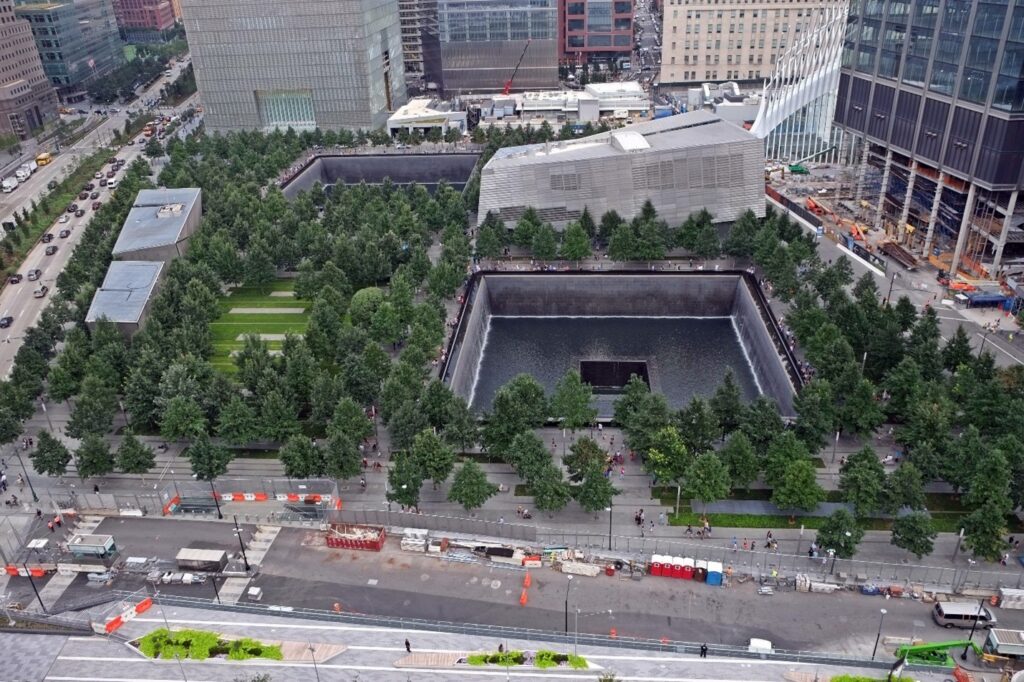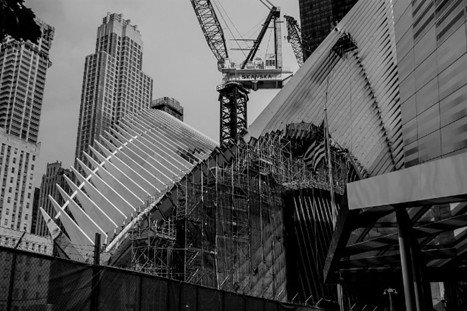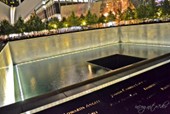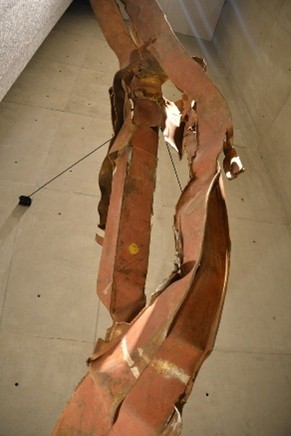
“9-11 Memorial and Museum (28815276064)” by Paul Sableman is licensed under CC BY 2.0.
About 9/11
This monument commemorates those who tragically died during the terrorist attacks on September 11, 2001. On September 11th a terrorist group called “al- Qaeda” which was founded by Osama Bin Laden hijacked four commercial planes. These planes targeted the World Trade Centers, the Pentagon, and presumably Washington DC. At 8:46 AM hijacked flight, Flight 11 flew into the World Trade Center’s North Tower. The second hijacked flight, Flight 175, flew into the World Trade Center’s South Tower at 9:03 AM. Flight 77 was then hijacked and crashed into the Pentagon. The South Tower collapsed followed by the North Tower. Flight 93 crashed into a field in Shanksville, Pennsylvania as passengers fought against the hijackers. Although we do not know for certain, this plane was likely targeting the White House or the US Capitol in Washington, DC. This monument commemorates the 2,977 people who lost their lives due to this attack. These casualties include fire responders who responded to the scene, those who were on the plane, and those who were inside or around the buildings. This memorial also commemorates the six people who died during the World Trade Center Bombing on February 26, 1993. These terrorist attacks initiated an international campaign known as the “Global War on Terror” led by the United States. The response to this led to military interventions in Afghanistan and Iraq.
Construction of the Memorial
The Lower Manhattan Development Corporation (LMDC) launched an international design competition in April of 2003 for the memorial remembering those who died during the September 11th attacks and the World Trade Center Bombing. The deadline for the competition was June 30, 2003, and by this time they had 5,201 submissions from 63 different countries. The competition was split into two phases and after the jury reviewed all the submissions, they picked 8 to move to final phase two. The 13 member jury was a mix of people from different backgrounds. It included architects, artists, family members of victims, Lower Manhattan residents and representatives from the Governor and Mayor’s offices. While the jury members had the ultimate decisions on the design they incorporated the public’s aspirations. “[The jury] looked for designs that honored the victims, spoke to the needs of families who lost loves ones, and provided space for healing and reflection” (“The Memorial”). They looked for these features as the reason behind building the memorial was to remember, honor and pay tribute to those killed in the attacks. The winning design was selected in January 2004 and was by Michael Arad and Peter Walker.

“Construction – 9/11 Memorial, NYC” by dolbinator1000 is licensed under CC BY 2.0.
Michael Arad, an architect, and Peter Walker, a landscape architect, titled their design: Reflecting Absence. The main feature of their design is the two twin waterfall pools which are encapsulated by a bronze wall including an inscription of the names of the victims who lost their lives. The memorial had to be understood by a diverse audience, hence their abstract design. On September 11, 2011, exactly 10 years after the 9/11 attacks the Memorial opened. This 10-year delay was due to the complex design process and funding. The location of this memorial in lower Manhattan is symbolic as it is the site where the Twin Towers once stood.
Features of the Memorial
There are many different design features of this memorial. Most notable are the two pools which are surrounded by a bronze parapet. Each is nearly an acre in size. The first portion of the waterfall is 30 feet deep, and the smaller portion is 20 feet deep. The interior of the reflecting pool is lined with black granite. Another feature of the memorial is the names inscribed on the bronze wall surrounding the pools. The names are grouped into categories of friends and colleagues, the crews of each flight, and first responder agencies and units. The North Pool includes 1,470 names of the victims of the North Tower, 6 names of the victims of the World Trade Center Bombing, and 87 names of the victims of Flight 11. The South Pool includes the 441 names of the first responders who were killed, 694 names of the victims of the South Tower, 40 names of the victims of Flight 93, 59 names from Flight 77 and 60 names from Flight 175, and 125 names of victims from the Pentagon.

“New York City – 9/11 Memorial” by Pascal Subtil is licensed under CC BY 2.0
Surrounding the memorial are 400 swamp white oak trees. This type of tree is native to the location of the three crash sites in New York City, Virginia, and Pennsylvania. In addition to swamp white oak trees there is one Callery pear tree which has now become known as the “Survivor Tree”. This tree was found in the rubble at Ground Zero and was nurtured back to health by the New York City Parks and Recreation Department. The tree was then returned to Ground Zero in 2010. In addition, the landscape includes a pathway with six large stones which was completed in 2019 and known as “The Memorial Glade”. These stones are inlaid with steel from the World Trade Center and at each end of the path, this is an inscription. The inscription reads, “This Memorial Glade is dedicated/ To those whose actions in our time of need/ Led to their injury, sickness and death/ Responders and recovery workers/ Survivors and community members/ Suffering long after September 11, 2001/ From exposure to hazards and toxins/ That hung heavy in the air/ Here and beyond this site known as Ground Zero/ And at the Pentagon/ And near Shanksville, Pennsylvania/ In the aftermath of the terrorist attack. Here we honor the tens of thousands/ From across American and around the world/ Who came to help and to heal/ Whose selflessness and resolve/ perseverance and courage/ Renewed the spirit of a grieving city/ Gave hope to the nation/ And inspired the world” (9/11 Memorial Glade). It is located near where the primary ramp was once located, which was essential during the rescue and recovery efforts.
Message of the Memorial
Many features of this memorial send messages about the event. The Survivor Tree is an example of resilience and perseverance as it survived 9/11 and was nursed back to health. The Memorial Glade represents and honors those who have died due to the aftermath of the attacks. First responders and recovery workers from all three sites suffered illnesses due to the exposure to the toxins. In addition, it recognizes the determination and perseverance of all those who participated in recovery efforts. The six stones in the Memorial Glade represent strength through adversity. The two pools sit in the footprint of both the North and South Tower. “According to the architect, Michael Arad, the pools represent “absence made visible.” Although water flows into the voids, they can never be filled” (“About the Memorial”). While choosing a design for the memorial one requirement was providing a space for healing and reflection. These pools do that as the sound of the falling water creates tranquility and a quiet place inside the hustle and bustle of New York City. The water falls in individual streams but comes together at the end symbolizing unity. Both pools have a secondary drop in the enter that goes down 30 feet making it impossible to see the bottoms. “The empty space symbolizes both the loss of life and the physical void left by the destruction of the Twin Towers” (Hammond).
According to the architect, Michael Arad, the pools represent “absence made visible.” Although water flows into the voids, they can never be filled.
About the Memorial
Public Reaction Overtime to 9/11 and the Memorial

9/11 Memorial North Pool World Trade Center WTC Manhattan New York City NY P00008 DSC_1319” by incognito7nyc is licensed under CC BY-NC 2.0.
The attacks on the World Trade Center and Pentagon brought Americans together in greater ways than the terrorists could have imagined. As large as New York City is people described it as having a “small town” feeling saying everyone knew someone who knew someone who died in the attacks. A year following the attacks there was debate over what to do with the 16- acre site. Some wanted to rebuild the towers while others wanted a small structure. However, everyone agreed that there must be a memorial (“Commemorating 9/11/01-9/11/02”). Approaching the 10th anniversary Harvey wrote in the Firehouse Magazine that many FDNY firefighters feel different about that day. Some members don’t want to relieve that day, but others want to participate in all the scheduled activities over the several days marking the 10th anniversary.
Joe Daniels the 9/11 Memorial President and Chief Executive Officer said in an interview with Am New York, “Anytime we open this Memorial, for some, it’ll be too soon, for others, it’ll be too late. The emotions are still so raw. Ten years feels like the right [amount of] time.” The memorial was opened to the victims’ families on the 10th anniversary of the attacks and opened the next day to the general public with the reservation of a visitor pass. Today the memorial while still a spot for families to mourn has become a spot for many tourists. While many tourists are respectful, Claudette Scheffold described that some are not. In an article she wrote on Medium she said, “When I see people posing at the pools, using selfie sticks, consulting maps, or following a tour guide, it reminds me of vacation and holiday, not a resting place for thousands of people and certainly not a place where two skyscrapers crumbled as a result of the worst terrorist attack in our country’s history.”
Today the site of the memorial is used annually for the 9/11 Remembrance Ceremony. Families gather on the Memorial Plaza to read 2,983 names of those who perished in the 9/11 attack and in the 1993 World Trade Center bombing. Throughout the ceremony, six moments of silence take place at the times each tower was struck and fell and the times of the attack on the Pentagon and crash on Flight 93. The ceremony starts at 8:30 in the morning and ends at around 1:00 in the afternoon. Many people attend including family members, former and current presidents, and members of the New York City Fire and Police Departments. The ceremony is live-streamed on TV for people to watch from their homes.
Anytime we open this Memorial, for some it’ll be too soon, for others, it’ll be too late. The emotions are still so raw. Ten years feels like the right [amount of] time.
Joe Daniels, 9/11 Memorial President and Chief Executive Officer
Controversy Over the Memorial
While there was some expressed controversy over the design of the memorial the majority of the controversy was sparked due to the museum associated with the memorial. Some people believe the museum does not treat Muslims and the victims’ families right. The museum brings in upwards of 3 million people each year as it is home to hundreds of artifacts ranging from fire trucks and steel columns to worn-out shoes. The museum teaches things from the events on 9/11 to the hunt for Osama Bin Laden. A film titled “The Outsider” which was directed by Steven Rosenbaum and Pamela Yoder was published speaking out against the museum. They felt the message of the museum was about grievance, not education. They also felt the vocabulary used by museum staff misleads the public about Islam and could affect how people treat Muslims. Another point the film addressed was the controversy over the gift shop at the museum. Although the revenue benefits the museum and its education programs the families of the victims feel as though it is insensitive.
Available Resources

“New York City 2015 9/11 Memorial & Museum” by thomasebunton is licensed under CC BY-NC 2.0.
Once of the biggest resources that are available to study this memorial and the events that inspired it is the 9/11 Museum. The museum was opened to the public on May 21st, 2014, and teaches the visitors the story of the 9/11 attacks and the 1993 World Trade Center bombing, the aftermath, and about the people who were affected by these events. The museum includes archaeological remnants that were saved at Ground Zero and are included in different exhibitions. In addition, the museum has a collection of material evidence, first-person testimonies, and historical records. They teach about the historical antecedents leading to the attack, the events of the attacks, and the aftermath and repercussions. The museum is open from Wednesday to Monday from 9 am – 7 pm and on some Tuesdays. The 9/11 Memorial and Museum’s website has a plethora of information about the memorial and its history.
“No day shall erase you from the memory of time” – Virgil
Works Cited
“9/11 Memorial Glade | National September 11 Memorial & Museum.” 911memorial.org, 2019, www.911memorial.org/visit/memorial/memorial-glade.
amNY. “Daniels Discusses Details of 9/11 Memorial Opening.” AmNewYork, 9 Sept. 2011, www.amny.com/news/daniels-discusses-details-of-911-memorial-opening/. Accessed 24 Apr. 2025.
Bloomberg, M. (2011, 07). 9/11 memorial accentuates NYC’s image restoration. PRweek, 14, 25. Retrieved from https://www.proquest.com/magazines/9-11-memorial-accentuates-nycs-image-restoration/docview/884403347/se-2
COMMEMORATING 9/11/01-9/11/02 part two: New york city. (2002). Enr, 249(11), 2-7. Retrieved from https://www.proquest.com/trade-journals/commemorating-9-11-01-02-part-two-new-york-city/docview/235736403/se-2
Eisner, H. (2011, 09). Hard to believe, 10 years later – never forget. Firehouse, 36, 8. Retrieved from https://www.proquest.com/magazines/hard-believe-10-years-later-never-forget/docview/893752217/se-2
Glade, Memorial. “PWP.” PWP, 17 Apr. 2022, www.pwpla.com/projects/911-memorial-glade. Accessed 24 Apr. 2025.
Hammond, Gabby. “911 Ground Zero | Rebuilding Ground Zero: Design of the 9/11 Memorial & Museum.” 911 Ground Zero, 30 Oct. 2020, 911groundzero.com/blog/rebuilding-ground-zero-architects-behind-911-memorial-museum/.
Huiskes, Katherine. “Timeline: The September 11 Terrorist Attacks.” Miller Center, Rector and Visitors of the University of Virginia, 2025, millercenter.org/remembering-september-11/september-11-terrorist-attacks.
In remembrance of september 11, 2001. (2002). Air Conditioning, Heating & Refrigeration News, 217(2), 27. Retrieved from https://www.proquest.com/trade-journals/remembrance-september-11-2001/docview/196480753/se-2
“Lower Manhattan Development Corporation.” Renewnyc.com, 2019, www.renewnyc.com/memorial/competition.asp. Accessed 24 Apr. 2025.
MANSOOR, SANYA. ““The Outsider” Unpacks the Controversy behind the National September 11 Memorial & Museum.” Time, 19 Aug. 2021, time.com/6091193/the-outsider-explainer-september-11-documentary/.
National Archives. “Global War on Terror | George W. Bush Library.” Www.georgewbushlibrary.gov, National Archives, 3 Jan. 2003, www.georgewbushlibrary.gov/research/topic-guides/global-war-terror.
“National September 11 Memorial.” PWP, www.pwpla.com/projects/reflecting-absence-national-september-11th-memorial.
Staff, The Week. “The 9/11 Memorial: “Poignant” or “Flawed by Bad Taste”?” The Week, 13 Sept. 2011, theweek.com/articles/481835/911-memorial-poignant-flawed-by-bad-taste. Accessed 24 Apr. 2025.
Scheffold, Claudette. “The 9/11 Memorial Feels Different Now – Claudette Scheffold – Medium.” Medium, 8 Sept. 2024, claudettes.medium.com/memorials-057bb0902791.
The Editors of Encyclopedia Britannica. “Al-Qaeda.” Encyclopædia Britannica, 2018, www.britannica.com/topic/al-Qaeda.
“The Memorial | National September 11 Memorial & Museum.” 911memorial.org, 2018, www.911memorial.org/visit/memorial.
